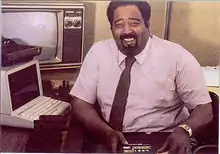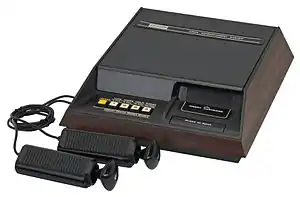Jerry Lawson (engineer)
Gerald Anderson "Jerry" Lawson (December 1, 1940 – April 9, 2011)[1][2] was an American electronic engineer. He is known for his work in designing the Fairchild Channel F video game console as well as leading the team that pioneered the commercial video game cartridge.[3] He has been dubbed by some as the "Father of Modern Gaming".[4]
Jerry Lawson | |
|---|---|
 Lawson, c. 1980 | |
| Born | December 1, 1940 Brooklyn, New York, U.S. |
| Died | April 9, 2011 (aged 70) Santa Clara, California, U.S. |
| Alma mater | Queens College |
| Occupation | Computer engineer |
| Children | 2 |
Early life
Lawson was born in Brooklyn, New York City, on December 1, 1940.[5] His father Blanton was a longshoreman with an interest in science, while his mother Mannings worked for the city, and also served on the PTA for the local school and made sure that he received a good education.[6] He had a grandfather that was educated as a physicist but was never able to achieve a career in physics, instead working as a postmaster.[7] Both of his parents encouraged his interests in scientific hobbies, including ham radio and chemistry. Lawson said that his first-grade teacher helped encourage him on his path to be someone influential similar to George Washington Carver.[5] While in high school, he earned money by repairing television sets. At the age of 13, he earned an amateur ham radio license. After receiving this license, he would save his money to buy parts from local electronic stores to build his own station in his room. He attended both Queens College and City College of New York, but did not complete a degree at either.[5]
Career

In 1970, he joined Fairchild Semiconductor in San Francisco as an applications engineering consultant within their sales division. While there, he created the early arcade game Demolition Derby in his garage.[5][6] Completed in early 1975 using Fairchild's new F8 microprocessors, Demolition Derby was among the earliest microprocessor-driven games.[8] In the mid-1970s, Lawson was made Chief Hardware Engineer[9] and director of engineering and marketing for Fairchild's video game division.[5] There, he led the development of the Fairchild Channel F console, released in 1976 and specifically designed to use swappable game cartridges based on technology licensed from Alpex.[3] At the time, most game systems had the game programming built into the game hardware, which could not be removed. Lawson and his team refined and improved technology developed at Alpex that allowed games stored as software on removable ROM cartridges that could be inserted and removed from a console unit repeatedly, and without electrically shocking the user. [3] This would allow users to buy into a library of games, and provided a new revenue stream for the console manufacturers through sales of these games.[10] The Channel F console featured a wide variety of controls, including a unique 8-way joystick designed by Lawson and a "pause" button, which was a first for a home video game console.[11] The Channel F was not a commercially successful product, but the cartridge approach was popularized with the Atari 2600 released in 1977.[12][13]
While he was with Fairchild, Lawson and Ron Jones were the sole black members of the Homebrew Computer Club, a group of early computer hobbyists that included a number of industry legends, including Apple founders Steve Jobs and Steve Wozniak.[12] Lawson had noted he had interviewed Wozniak for a position at Fairchild, but did not hire him.[5]
In 1980, Lawson left Fairchild and founded Videosoft, a video game development company that made software for the Atari 2600 in the early 1980s, as the 2600 had displaced the Channel F as the top system in the market.[3][14] Videosoft closed about five years later, and Lawson started to take on consulting work. At one point, he had been working with Stevie Wonder to produce a "Wonder Clock" that would wake a child with the sound of a parent's voice, though it never made it to production.[10] Lawson later worked with the Stanford mentor program and was preparing to write a book on his career.[12]
In March 2011, Lawson was honored as an industry pioneer for his work on the game cartridge concept by the International Game Developers Association (IGDA).[10] Lawson was honored with the ID@Xbox Gaming Heroes award at the 21st Independent Games Festival on March 20, 2019 for leading the development of the first cartridge-based game console.[15]
There is a display of Lawson's contribution to the gaming industry on permanent display at The World Video Game Hall of Fame at The Strong National Museum of Play in Rochester, New York.[16]
Death
Around 2003, Lawson started having complications from diabetes, losing the use of one leg and sight from one eye.[6] On April 9, 2011, about one month after being honored by the IGDA, he died of complications from diabetes.[5][10] At the time of his death, he resided in Santa Clara, California, and was survived by his wife, two children, and his brother.[5]
In popular culture
A short documentary on Jerry Lawson and his development of the Fairchild Channel F was produced by The Czar of Black Hollywood director Bayer Mack and released by Block Starz Music Television as part of its Profiles of African-American Success video series.[17]
He was also featured in the first episode of the Netflix limited-series documentary High Score, released August 19, 2020, with his story told by his children Karen and Anderson.[18]
The first episode of Season 6 of Command Line Heroes, "Jerry Lawson: The Engineer Who Changed the Game", covers his work on the Channel F.[19]
Footnotes
- Cifaldi, Frank. "Video Games Pioneer Jerry Lawson Dies". 1up. Archived from the original on 2011-04-30.
- "VC&G | VC&G Interview: Jerry Lawson, Black Video Game Pioneer". www.vintagecomputing.com. Retrieved June 28, 2015.
- "The Untold Story Of The Invention Of The Game Cartridge". FastCompany.
- Kennedy, Rayondon (2013). "Titans of Science: Gaming Sidebar". US Black Engineer and Information Technology. 37: 27–28 – via ProQuest.
- Weber, Bruce (April 13, 2011). "Gerald A. Lawson, Video Game Pioneer, Dies at 70". The New York Times.
- McLennan, Dennis (April 23, 2011). "Gerald Lawson dies at 70; engineer brought cartridge-based video game consoles to life". Los Angeles Times. Retrieved February 8, 2017.
- Dubois, Chantelle (June 11, 2018). "Engineers of History: Jerry Lawson, Video Game Pioneer". All About Circuits. Retrieved November 6, 2019.
- Saucier, Jeremy (December 2, 2013). "Collection Documents the Career of Video Game Pioneer Jerry Lawson". The Strong: National Museum of Play. Retrieved December 2, 2019.
- CG Expo 99 Panel announcement
- Cassidy, Mike (March 3, 2011). "Gaming industry finally recognizes the work of a pioneer". San Jose Mercury News. Retrieved February 8, 2017.
- Wolf, Mark (2007). The Video Game Explosion: A History from PONG to Playstation and Beyond. Westport, CT: Greenwood. p. 56. ISBN 978-0313338687.
- "Interview: Jerry Lawson, Black Video Game Pioneer". Vintage Computing and Gaming, February 24, 2009.
- "Jerry Lawson, a self-taught engineer, gave us video game cartridges". Engadget. Retrieved June 28, 2015.
- Squires, David (August 1985). "The Mixed Signals in High Tech's Future". Black Enterprise. p. 109.
- "Return of the Obra Dinn takes Grand Prize at the 21st IGF Awards!". Gamasutra. March 20, 2019. Retrieved March 20, 2019.
- Snider, Mike (February 27, 2020). "Before Nintendo and Atari: How a black engineer changed the video game industry forever". USA Today.
- "A Black Man Developed the First Cartridge Video Game Console". YouTube.com. February 10, 2020. Retrieved February 11, 2020.
- Machkovech, Sam (August 12, 2020). "High Score review: Netflix's story of gaming's "golden age" is honestly solid". Ars Technica. Retrieved August 12, 2020.
- "Jerry Lawson: The Engineer Who Changed the Game". RedHat. October 15, 2020.
References
- 2006 Vintage Computing Festival interview video
- Jerry Lawson Biography
- "Computer Gaming '99 Expo Panel Announcement". Retrieved 2009-03-11.
- Edwards, Benj. "VC&G Interview: Jerry Lawson, Black Video Game Pioneer". Retrieved 2009-03-11.